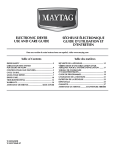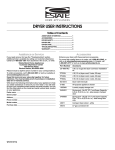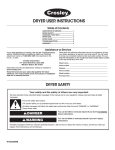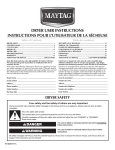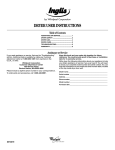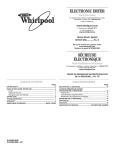Download Maytag W10096989B Use & care guide
Transcript
ELECTRONIC DRYER USE AND CARE GUIDE SÉCHEUSE ÉLECTRONIQUE GUIDE D’UTILISATION ET D’ENTRETIEN Para una versión de estas instrucciones en español, visite www.maytag.com Table of Contents DRYER SAFETY ...............................................................2 CHECK YOUR VENT SYSTEM FOR GOOD AIR FLOW ..................................................4 CONTROL PANEL AND FEATURES.................................5 CYCLE GUIDE.................................................................6 USING YOUR DRYER .....................................................7 DRYER CARE .................................................................10 TROUBLESHOOTING ..................................................12 WARRANTY ..................................................................14 ASSISTANCE OR SERVICE........................... BACK COVER W10096989B W10097006B-SP Table des matières SÉCURITÉ DE LA SÉCHEUSE .........................................15 VÉRIFICATION D’UNE CIRCULATION D’AIR ADÉQUATE POUR LE SYSTÈME D’ÉVACUATION ........17 TABLEAU DE COMMANDE ET CARACTÉRISTIQUES................................................18 GUIDE DE PROGRAMMES ...........................................19 UTILISATION DE LA SÉCHEUSE ...................................21 ENTRETIEN DE LA SÉCHEUSE ......................................23 DÉPANNAGE. ...............................................................25 GARANTIE. ...................................................................27 ASSISTANCE OU SERVICE. ......... COUVERTURE ARRIÈRE DRYER SAFETY 2 3 CHECK YOUR VENT SYSTEM FOR GOOD AIR FLOW Maintain good air flow by: Cleaning your lint screen before each load. Replace plastic or foil vent material with 4" (102 mm) diameter heavy, rigid vent material. Use the shortest length of vent possible. Use no more than four 90° elbows in a vent system; each bend and curve reduces air flow. Good Better Good air flow Along with heat, dryers require good air flow to efficiently dry laundry. Proper venting will reduce your drying times and improve your energy savings. See Installation Instructions. The venting system attached to the dryer plays a big role in good air flow. Service calls caused by improper venting are not covered by the warranty and will be paid by the customer, regardless of who installed the dryer. Remove lint and debris from the exhaust hood. Remove lint from the entire length of the vent system at least every 2 years. When cleaning is complete, be sure to follow the Installation Instructions supplied with your dryer for final product check. Clear away items from the front the dryer. Use Sensor Cycles for better fabric care and energy savings Use the Sensor Cycles to provide the most energy savings and enhanced fabric care from the dryer. During Sensor Cycles, drying air temperature and moisture level are sensed in the load. This sensing occurs throughout the drying cycle and the dryer shuts off when the load reaches the selected dryness. The dryer will default to Normal Dryness Level to save energy. With Timed Dry, the dryer runs the amount of time set and sometimes results in shrinkage, wrinkling, and static due to over-drying. Use Timed Dry for the occasional damp load that needs a little more drying time or when using the drying rack. 4 CONTROL PANEL & FEATURES 1 2 3 5 6 4 Not all features and options are available on all models. Appearance may vary. 1 POWER/CANCEL BUTTON 5 MODIFIERS Press to turn the dryer on and off. 2 Temp Level (for use with Timed Cycles only) DRYER CYCLE KNOB Select a drying temperature based on the fabrics in your load. If you are unsure of the temperature to select for a load, select the lower setting rather than the higher setting. NOTE: The Air Dry Temp Level Feature is not available on the Sensor Cycles. Use your Dry Cycle Knob to select available cycles on your dryer. Turn the knob to select a cycle for your laundry load. See “Cycle Guide” for detailed descriptions of cycles. 3 START/PAUSE BUTTON Press to start a cycle, or press once while a cycle is in process to pause it. 4 Dryness Level (for use with Sensor Cycles only) Use the Dryness option to select dryness levels for the Sensor Cycles only. OPTIONS Wrinkle Prevent Feature Drum Light When you are unable to remove a load of clothes from the dryer as soon as it stops, wrinkles can form. The WRINKLE PREVENT feature periodically tumbles, rearranges, and fluffs the load to help keep wrinkles from forming. Get up to 60 or 150 minutes for models with two choices, 90 minutes for models with only one choice of heat-free, periodic tumbling at the end of a cycle. Press the WRINKLE PREVENT button to turn ON or OFF at any time before the cycle has ended. Select Drum Light to turn on the light inside the dryer drum. When pressed during a cycle or not running, the Drum Light turns on and will remain on until DRUM LIGHT is pressed again, or the door is opened and closed, or the door is left open for 30 minutes. Press DRUM LIGHT at any time to turn the drum light ON or OFF. Damp Dry Signal (for use with Sensor Cycles only) Selecting the Damp Dry Signal will alert you when your clothes are approximately 80% dry. This is useful when you want to remove lightweight items in a mixed load to avoid overdrying or remove partially dry items that may need ironing. End Signal The End Signal produces an audible sound when the drying cycle is finished. Promptly removing clothes at the end of the cycle reduces wrinkling. Press END SIGNAL until the desired volume (Hi, Low, or Off) is selected. NOTE: When the Wrinkle Prevent setting is selected and the End Signal is on, the tone will sound every 20 minutes until the clothes are removed, or the Wrinkle Prevent setting ends. Timed Dry (for use with Timed Cycles only) Will run the dryer for the specified time on the control. Depending on model, temperature may be selected on the cycle knob or may be located on a separate control. 6 CYCLE STATUS LIGHTS Lights indicate the progress of the drying cycles. 5 CYCLE GUIDE — SENSOR DRY CYCLES Not all cycles and settings are available on all models. Settings and options shown in bold are default settings for that cycle. SENSOR DRY CYCLE - Senses moisture in the load or air temperature and shuts off when the load reaches the selected dryness level. Gives the best drying in the shortest time. Drying time varies based on fabric type, load size, and dryness setting. Use the NORMAL dryness level to provide optimal energy savings. Depending on model, temperature may be selected on cycle knob or be a separate control. Items to dry: Cycle: Drying Temperature: Dryness Level: Default Time: Towels, bedding, children’s clothing Sanitize High More Normal Less 60 Damp Dry Signal This cycle is designed to Wrinkle Prevent eliminate 99.9% of 3 common infectious bacteria. This cycle should be run to completion to ensure sanitization. For best results, do not interrupt cycle. Heavyweight items towels, jeans Heavy Duty High More Normal Less 50 Damp Dry Signal Wrinkle Prevent Use for drying large or heavy items. Evenly dries large or heavy loads. Eco Normal Medium More Normal Less 38 Damp Dry Signal Wrinkle Prevent Average size loads of medium weight items where improved energy is desired. Corduroys, work clothes Normal Medium More Normal Less 40 Damp Dry Signal Wrinkle Prevent Medium to large loads of mixed fabrics and items. Sport shirts, casual business clothes, and permanent press blends Wrinkle Control Low More Normal Less 35 Damp Dry Signal Wrinkle Prevent For normal light- to medium-weight fabrics. Drying time varies based on fabric type, load size, and dryness setting. Small loads, lightweight items Delicate Low More Normal Less 30 Damp Dry Signal Wrinkle Prevent For gently drying delicate items. Lingerie, exercise wear, washable woolens Extra Delicate Extra Low More Normal Less 25 Damp Dry Signal Wrinkle Prevent For gently drying delicate items. Work clothes, casual wear, mixed cottons, sheets, corduroys Available Options: Cycle Details: NOTE: If loads do not seem as dry as you would like, select More Dry the next time you dry a similar load. If loads seem drier than you like, select Less Dry the next time you dry a similar load. CYCLE GUIDE — TIMED DRY CYCLES Not all cycles and settings are available on all models. Settings and options shown in bold are default settings for that cycle. TIMED DRY - Will run the dryer for the specified time on the control. Depending on model, temperature may be selected on cycle knob or be a separate control. Cycle: Drying Temperature: Default Time: Available Options: Cycle Details: Any load Timed Dry Any N/A Temp Level Wrinkle Prevent Time Adjustment Dries items to a damp level for items that do not require an entire drying cycle. Select a drying temperature based on the fabrics in your load. If you are unsure of the temperature to select for a load, select the lower setting rather than the higher setting. Small loads and sportswear (2 to 3 items) Rapid Dry Any 15 Temp Level Wrinkle Prevent Time Adjustment For small loads of 2-3 items. Mixed loads Touch Up Any 15 Temp Level Wrinkle Prevent Time Adjustment Use to remove wrinkles, including loads left in the dryer too long. Any timed dry cycle/ manual cycle does not sense the load. Rubber, plastic, heat sensitive fabrics Timed Dry Air Dry N/A Temp Level Wrinkle Prevent Time Adjustment Use a no heat (air dry) setting for foam, rubber, plastic, or heat-sensitive fabrics. N/A After a cycle is complete, the load is periodically tumbled to avoid wrinkles until you are ready to remove it. Items to dry: SPECIAL SETTINGS: Any load 6 Added at the end of certain cycles to reduce wrinkling. Wrinkle Prevent No heat N/A Setting the Drying Temperature Select a drying temperature based on the fabrics in your load. If you are unsure of the temperature to select for a load, select the lower setting rather than the higher setting. Temperature Tips If your dryer has multiple heat settings: A High heat setting may be used for drying heavyweight items such as towels and work clothes. A Low to Medium heat setting may be used for drying mediumweight items such as sheets, blouses, dresses, underwear, permanent press fabrics, and some knits. An Extra-Low heat setting may be used for drying lightweight items such as lingerie. Use a no heat (air dry) setting for foam, rubber, plastic, or heat-sensitive fabrics. Line dry bonded or laminated fabrics. NOTE: If you have questions about drying temperatures for various loads, refer to the care label directions. USING YOUR DRYER 1. Clean the lint screen Clean the lint screen before each load. Pull the lint screen straight up. Roll lint off the screen with your fingers. Do not rinse or wash screen to remove lint. Push the lint screen firmly back into place. For additional cleaning information, see “Dryer Care.” 2. Load the dryer Place laundry in the dryer. Close the door. Do not overload the dryer; clothes should be able to tumble freely. 7 3. Press POWER/CANCEL 5. Setting modifiers Press the POWER/CANCEL button to turn on the dryer. 4. Select the desired cycle The default cycle settings will be shown. For some cycles, you may select alternate settings by pressing the button for that setting. Time adjusts for Manual Cycles only. NOTE: Not all modifiers are available with all cycles. Temp Level (for use with Timed Cycles only) Press the TEMP LEVEL button to change the drying temperature from the default setting. Press the (+) for more time or (-) less time and the time will change by 1-minute intervals. Press and hold (+) for more time or (-) less time and the time will change by 5-minute intervals. Select the desired cycle for your load. See the “Cycle Guide” or the display for more information about each cycle. Dryness Level (for use with Sensor Cycles only) Normal dryness level is a good starting point for optimal energy savings. You can select a different dryness level, depending on your load, by pressing the button for More, Normal, or Less. Selecting More, Normal, or Less automatically adjusts the dryness level at which the dryer will shut off. Once a dryness level is set, it cannot be changed without stopping the cycle. Sensor Dry cycles give the best drying in the shortest time. Drying time varies based on fabric type, load size, and dryness setting. NOTE: More Dry removes more load moisture. Normal Dry is used for a starting point for sensor drying. Less Dry removes less moisture and used for loads you may want to put on a hanger to complete drying. Wrinkle Prevent feature Get up to 60 or 150 minutes for models with two choices, 90 minutes for models with only one choice of heat-free, periodic tumbling at the end of a cycle. Press the WRINKLE PREVENT button to turn ON or OFF at any time before the cycle has ended. The WRINKLE PREVENT feature is preset to “OFF.” If selected for other cycles, the WRINKLE PREVENT feature setting will remain “ON” the next time that cycle is selected. 8 6. Select cycle options (if desired) Add additional options by pressing the button. NOTE: Not all options and settings are available with all cycles. 8. Remove garments promptly after cycle is finished Promptly remove garments after cycle has completed to reduce wrinkling. Use the Wrinkle Prevent feature to avoid wrinkling when you are unable to remove a load from the dryer as soon as it stops. 9. Additional features (on some models) 7. Press START/PAUSE to begin cycle Select Drum Light to turn on the light inside the dryer drum. When pressed during a cycle or not running, the Drum Light turns on and will remain on until DRUM LIGHT is pressed again, the door is opened and closed, or the door is left open for 30 minutes. Press the START/PAUSE button to begin the cycle. 9 DRYER CARE Cleaning the dryer location Cleaning the lint screen Keep dryer area clear and free from items that would block the air flow for proper dryer operation. This includes clearing piles of laundry in front of the dryer. Every load cleaning The lint screen is located in the door opening of the dryer. A screen blocked by lint can increase drying time. To clean: 1. Pull the lint screen straight up. Roll lint off the screen with your fingers. Do not rinse or wash screen to remove lint. Cleaning the dryer interior To clean dryer drum 1. Apply a liquid, nonflammable household cleaner to the stained area of the drum and rub with a soft cloth until stain is removed. 2. Wipe drum thoroughly with a damp cloth. 3. Tumble a load of clean cloths or towels to dry the drum. NOTE: Garments that contain loose dyes, such as denim blue jeans or brightly colored cotton items, may discolor the dryer interior. These stains are not harmful to your dryer and will not stain future loads of clothes. Dry these items inside out to avoid drum staining. 2. Push the lint screen firmly back into place. IMPORTANT: Do not run the dryer with the lint screen loose, damaged, blocked, or missing. Doing so can cause overheating and damage to both the dryer and fabrics. If lint falls off the screen into the dryer during removal, check the exhaust hood and remove the lint. See “Venting Requirements.” As needed cleaning Laundry detergent and fabric softener residue can build up on the lint screen. This buildup can cause longer drying times for your clothes, or cause the dryer to stop before your load is completely dry. The screen is probably clogged if lint falls off while the screen is in the dryer. Clean the lint screen with a nylon brush every 6 months, or more frequently, if it becomes clogged due to a residue buildup. To wash: 1. Roll lint off the screen with your fingers. 2. Wet both sides of lint screen with hot water. 3. Wet a nylon brush with hot water and liquid detergent. Scrub lint screen with the brush to remove residue buildup. Removing accumulated lint From Inside the Dryer Cabinet Lint should be removed every 2 years, or more often, depending on dryer usage. Cleaning should be done by a qualified servicer. From the Exhaust Vent Lint should be removed every 2 years, or more often, depending on dryer usage. 10 4. Rinse screen with hot water. 5. Thoroughly dry lint screen with a clean towel. Reinstall screen in dryer. Vacation, storage, and moving care Non-Use or Storage Care Operate your dryer only when you are at home. If you will be on vacation or not using your dryer for an extended period of time, you should: 1. Unplug dryer or disconnect power. 2. Clean lint screen. See “Cleaning the Lint Screen.” Changing the drum light (on some models) 1. Unplug dryer or disconnect power. 2. Open the dryer door. Locate the light bulb cover on the back wall of the dryer. Using a Phillips head screw driver, remove the screw located in the lower right-hand corner of the cover. Remove the cover. Moving Care For power supply cord-connected dryers: 1. Unplug the power supply cord. 2. Make sure leveling legs are secure in dryer base. 3. Use tape to secure dryer door. 3. Turn bulb counterclockwise. Replace the bulb with a 10-watt appliance bulb only. Replace the cover and secure with the screw. 4. Plug in dryer or reconnect power. Changing the Sensor Cycle Settings to Increase Drying Time For direct-wired dryers: 1. Disconnect power. 2. Disconnect wiring. 3. Make sure leveling legs are secure in dryer base. 4. Use tape to secure dryer door. Reinstalling the Dryer Follow the “Installation Instructions” to locate, level, and connect the dryer. If all your loads on all Sensor cycles are consistently not as dry as you would like, you may change the default settings to increase the default dryness level. Your sensor drying settings can be adjusted to adapt to different installations, environmental conditions or personal preference. This change is retained and will affect all of your Sensor cycles, not just the current cycle/load. There are 3 drying settings, which are displayed using the time display: 01 Factory preset dryness level. 02 Slightly drier clothes, 15% more drying time. 03 Much drier clothes, 30% more drying time. To change the drying settings: NOTE: The settings cannot be changed while the dryer is running or paused. The dryer must be in standby mode (the power button is off) to adjust the default settings. 1. Before starting a cycle, press and hold the TEMP LEVEL button for 6 seconds. 2. Press the TEMP LEVEL button to select the dryness level shown in the time display: 01, 02, or 03. 3. Press START/PAUSE to save the new dryness level setting. 11 TROUBLESHOOTING First try the solutions suggested here or visit our website and reference FAQs (Frequently Asked Questions) to possibly avoid the cost of a service call...In U.S.A. http://www.maytag.com/help - In Canada www.maytag.ca If you experience Clothes are not drying satisfactorily, drying times are too long, or load is too hot Dryer will not run Unusual sounds No heat 12 Solution Possible Causes Lint screen clogged with lint. Lint screen should be cleaned before each load. Has the Air Dry cycle been selected. Select the right cycle for the types of garments being dried. See “Air Dry.” Load too large and heavy to dry quickly. Separate the load to tumble freely. Exhaust vent or outside exhaust hood clogged with lint, restricting air movement? Run the dryer for 5–10 minutes. Hold your hand under the outside exhaust hood to check air movement. If you do not feel air movement, clean exhaust system of lint or replace exhaust vent with heavy metal or flexible metal vent. See “Installation Instructions.” Fabric softener sheets blocking the grille. Use only one fabric softener sheet, and use it only once. Exhaust vent the correct length? Check that the exhaust vent is not too long or has too many turns. Long venting will increase drying times. See the Installation Instructions. Exhaust vent diameter the correct size. Use 4" (102 mm) diameter vent material. Dryer located in a room with temperature below 45ºF (7ºC)? Proper operation of dryer cycles requires temperatures above 45ºF (7ºC). Dryer located in a closet. Closet doors must have ventilation openings at the top and bottom of the door. The front of the dryer requires a minimum of 1" (25 mm) of airspace, and, for most installations, the rear of the dryer requires 5" (127 mm). See “Installation Instructions.” Door not closed completely. Make sure the dryer door is closed completely. START/PAUSE button not pressed firmly or held long enough. Press and HOLD the START/PAUSE button until you hear the dryer drum moving. Household fuse is blown or circuit breaker has tripped. Electric dryers use 2 household fuses or circuit breakers. The drum may be turning, but you may not have heat. Replace the fuse or reset the circuit breaker. If the problem continues, call an electrician. Incorrect power supply. Electric dryers require 240-volt power supply. Check with a qualified electrician. Wrong type of fuse. Use a time-delay fuse. Dryer have a period of non-use. If the dryer hasn’t been used for awhile, there may be a thumping sound during the first few minutes of operation. Is a coin, button, or paper clip caught between the drum and front or rear of the dryer? Check the front and rear edges of the drum for small objects. Clean out pockets before laundering. Is it a gas dryer? The gas valve clicking is a normal operating sound. Are the four legs installed, and is the dryer level front to back and side to side? The dryer may vibrate if not properly installed. See “Installation Instructions.” Clothing knotted or balled up. When balled up, the load will bounce, causing the dryer to vibrate. Separate the load items and restart the dryer. Household fuse is blown or circuit breaker has tripped. The drum may be turning, but you may not have heat. Electric dryers use 2 household fuses or circuit breakers. Replace both fuses or reset the circuit breaker. If the problem continues, call an electrician. Supply line valve not open. For gas dryers, is the valve open on the supply line. Incorrect power supply. Electric dryers require 240-volt power supply. Check with a qualified electrician. TROUBLESHOOTING cont. First try the solutions suggested here or visit our website and reference FAQs (Frequently Asked Questions) to possibly avoid the cost of a service call...In U.S.A. http://www.maytag.com/help - In Canada www.maytag.ca If you experience Dryer displaying code message Cycle time too short Possible Causes Solution “PF” (power failure), Start LED flashes Was the drying cycle interrupted by a power failure? Press START/PAUSE to restart the dryer. “F# E#” (F1 E1, F3 E1, etc.) variable service codes. If a code beginning with an “F” appears in the display. Alternating between F# and E#, the dryer control has detected a problem that requires service. Call for service. Sensor cycle ending early. The load may not be contacting the sensor strips. Level the dryer. Use Timed Dry for very small loads. Change the dryness level setting on Sensor Cycles. Increasing or decreasing the dryness level will change the amount of drying time in a cycle. If loads are consistently ending too early, see also Changing the Sensor Dry Default Settings. Lint on load Lint screen clogged. Lint screen should be cleaned before each load. Stains on load or drum Dryer fabric softener not properly used. Add dryer fabric softener sheets at the beginning of the cycle. Fabric softener sheets added to a partially dried load can stain your garments. Drum stains are caused by dyes in clothing (usually blue jeans). These will not transfer to other clothing. Loads are wrinkled Load not removed from dryer at the end of the cycle. Select Touch Up Cycle to tumble the load with water and heat. This cycle is best for smoothing out wrinkles and reducing odors from loads consisting of wrinkle-free cotton, cotton polyester blends, common knits and synthetic garments. NOTE: Refer to garment care label instructions. Dry clean only garments are not recommended. Dryer overloaded. Dry smaller loads that can tumble freely. Have you recently been painting, staining, or varnishing in the area where your dryer is located? If so, ventilate the area. When the odors or fumes are gone from the area, rewash and dry the clothing. Is the electric dryer being used for the first time? The new electric heating element may have an odor. The odor will be gone after the first cycle. Were laundry items removed from the dryer before the end of the cycle? Allow the Cool Down cycle to finish before removing laundry from dryer. All cycles are cooled slowly to reduced wrinkling and make it easier to handle. Items removed before Cool Down may feel very warm. Was a high temperature cycle used, or was a separate temperature control set on high? Select a lower temperature, and use a sensor drying cycle. These cycles sense the temperature or the moisture level in the load and shut off when the load reaches the selected dryness. This reduces overdrying. Odors Load is too hot 13 MAYTAG® LAUNDRY WARRANTY LIMITED WARRANTY For one year from the date of purchase, when this major appliance is operated and maintained according to instructions attached to or furnished with the product, Maytag brand of Whirlpool Corporation or Whirlpool Canada LP (hereafter “Maytag”) will pay for factory specified parts and repair labor to correct defects in materials or workmanship that existed when this major appliance was purchased. Service must be provided by a Maytag designated service company. YOUR SOLE AND EXCLUSIVE REMEDY UNDER THIS LIMITED WARRANTY SHALL BE PRODUCT REPAIR AS PROVIDED HEREIN. This limited warranty is valid only in the United States or Canada and applies only when the major appliance is used in the country in which it was purchased. Proof of original purchase date is required to obtain service under this limited warranty. ITEMS EXCLUDED FROM WARRANTY This limited warranty does not cover: 1. Replacement parts or repair labor if this major appliance is used for other than normal, single-family household use or when it is used in a manner that is inconsistent to published user or operator instructions and/or installation instructions. 2. Service calls to correct the installation of your major appliance, to instruct you on how to use your major appliance, to replace or repair house fuses, or to correct house wiring or plumbing. 3. Service calls to repair or replace appliance light bulbs, air filters or water filters. Consumable parts are excluded from warranty coverage. 4. Damage resulting from accident, alteration, misuse, abuse, fire, flood, acts of God, improper installation, installation not in accordance with electrical or plumbing codes, or use of products not approved by Maytag. 5. Cosmetic damage, including scratches, dents, chips or other damage to the finish of your major appliance, unless such damage results from defects in materials or workmanship and is reported to Maytag within 30 days from the date of purchase. 6. Pick up and delivery. This major appliance is intended to be repaired in your home. 7. Repairs to parts or systems resulting from unauthorized modifications made to the appliance. 8. Expenses for travel and transportation for product service if your major appliance is located in a remote area where service by an authorized Maytag servicer is not available. 9. The removal and reinstallation of your major appliance if it is installed in an inaccessible location or is not installed in accordance with Maytag published installation instructions. 10. Replacement parts or repair labor on major appliances with original model/serial numbers that have been removed, altered, or cannot be easily determined. DISCLAIMER OF IMPLIED WARRANTIES IMPLIED WARRANTIES, INCLUDING ANY IMPLIED WARRANTY OF MERCHANTABILITY OR IMPLIED WARRANTY OF FITNESS FOR A PARTICULAR PURPOSE, ARE LIMITED TO ONE YEAR OR THE SHORTEST PERIOD ALLOWED BY LAW. Some states and provinces do not allow limitations on the duration of implied warranties of merchantability or fitness, so this limitation may not apply to you. This warranty gives you specific legal rights, and you also may have other rights that vary from state to state or province to province. LIMITATION OF REMEDIES; EXCLUSION OF INCIDENTAL AND CONSEQUENTIAL DAMAGES YOUR SOLE AND EXCLUSIVE REMEDY UNDER THIS LIMITED WARRANTY SHALL BE PRODUCT REPAIR AS PROVIDED HEREIN. MAYTAG SHALL NOT BE LIABLE FOR INCIDENTAL OR CONSEQUENTIAL DAMAGES. Some states and provinces do not allow the exclusion or limitation of incidental or consequential damages, so these limitations and exclusions may not apply to you. This warranty gives you specific legal rights, and you also may have other rights that vary from state to state or province to province. If outside the 50 United States and Canada, contact your authorized Maytag dealer to determine if another warranty applies. If you think you need repair service, first see the “Troubleshooting” section of the Use & Care Guide. If you are unable to resolve the problem after checking “Troubleshooting,” additional help can be found by checking the “Assistance or Service” section or by calling Maytag. In the . In Canada, call . 6/08 U.S.A., call Keep this book and your sales slip together for future reference. You must provide proof of purchase or installation date for inwarranty service. Write down the following information about your major appliance to better help you obtain assistance or service if you ever need it. You will need to know your complete model number and serial number. You can find this information on the model and serial number label located on the product. 14 Dealer name ____________________________________________________ Address _________________________________________________________ Phone number ___________________________________________________ Model number ___________________________________________________ Serial number ___________________________________________________ Purchase date ___________________________________________________















